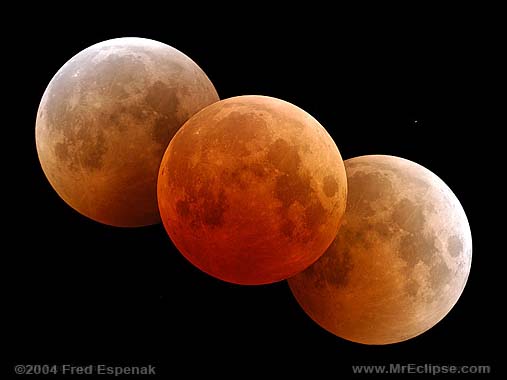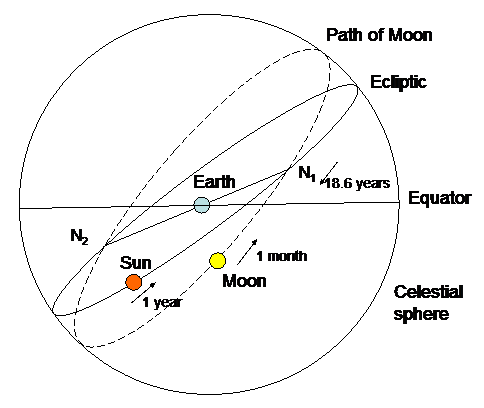Why Don't Minor Changes In The Moon's Size Affect Lunar Eclipses?

A solar eclipse happens at new moon, when the moon passes between the lord's day and Earth. A lunar eclipse happens at the contrary moon phase – at full moon – when the World, dominicus and moon align in space, with Earth between the sun and moon. At such times, Earth's shadow falls on the total moon, darkening the moon'south confront and – at mid-eclipse – sometimes turning it a coppery blood-red. Nosotros typically have betwixt four and seven eclipses – some partial, some total, some lunar and some solar every year. Why aren't there eclipses at every total and new moon?
The moon takes almost a month to orbit around the Earth. If the moon orbited in the same plane every bit the ecliptic – Earth'due south orbital plane – we would have a minimum of two eclipses every month. In that location'd be an eclipse of the moon at every full moon. And, one fortnight (approximately two weeks) later there'd be an eclipse of the sun at new moon for a full of at least 24 eclipses every year.
Merely that doesn't happen, and the reason is that the moon's orbit around Earth is inclined to Earth'south orbit around the sunday by about 5 degrees. Twice a month the moon intersects the ecliptic – Earth's orbital aeroplane – at points called nodes. If the moon is going from south to northward in its orbit, it's called an ascending node. If the moon is going from north to southward, information technology'south a descending node.
If the total moon or new moon sweeps appreciably close to i of these nodes, then an eclipse is not just possible – but inevitable.

Solar and lunar eclipses always come in pairs, with one post-obit the other in a period of ane fortnight (approximately two weeks). For case, the descending node total lunar eclipse on May 26, 2021, volition exist followed by an ascending node annular solar eclipse on June 10, 2021.
Then exactly six lunar months (six full moons) subsequently this descending node total lunar eclipse on May 26, 2021, at that place will exist an ascending node partial lunar eclipse on Nov 19, 2021.
Then exactly 6 lunar months (six new moons) afterward the ascending node annular solar eclipse of June ten, 2021, in that location volition be a descending node total solar eclipse on December iv, 2021.
Generally, two eclipses – one solar and one lunar – occur in ane eclipse season, a catamenia lasting approximately 34 to 35 days. Sometimes, though, when the initial eclipse happens sufficiently early in the eclipse flavour, there can be three eclipses in ane eclipse season (two solar and ane lunar, or two lunar and i solar). This final happened in July-August 2020 (lunar/solar/lunar), and will next happen in June-July 2029 (solar/lunar/solar).
Read more: How often are at that place 3 eclipses in a calendar month?
This year, in 2021, the centre of the eclipse season falls on June i and Nov 23. At the middle of an eclipse flavor, which recurs in periods of nearly 173 days, the lunar nodes are in exact alignment with the World and lord's day.
The video below explains why a pair of eclipses happens when the new moon and total moon are closely aligned with the lunar nodes.
In that location might be some unfamiliar words in this video, including ecliptic and node. The ecliptic is the airplane of World's orbit around the dominicus. The moon'south orbit is inclined to the plane of the ecliptic. The nodes are the two points where the moon's orbit and the ecliptic intersect.
Relative to the moon's nodes, the moon's phases recur almost thirty degrees farther eastward (counterclockwise) forth the zodiac each month. So the adjacent pair of eclipses won't be forthcoming for nigh some other six calendar months (6 10 30 degrees = 180 degrees), to fall on Nov 19 and December 4, 2021.
Node passages of the moon: 2001 to 2100
Phases of the moon: 2001 to 2100
The following new moon and full moon happen most 30 degrees farther eastward as measured by the constellations of the zodiac in about 29.5 days. Merely the moon returns to its node a good two days earlier than that, or in nearly 27.ii days. Subsequently the eclipses of May 26 and June 10, 2021, information technology'll exist a waxing gibbous moon (not a full moon) that crosses the moon'due south descending node on June 23, 2021, and a waning crescent moon (not a new moon) that crosses the moon's ascending node on July 6, 2021.
Fifty-fifty though the moon's orbit is inclined to that of Earth – and even though there's not an eclipse with every new and total moon – in that location are more than eclipses than you might recall. All are marvelous to behold. They're a reminder that we alive on a planet and a take chances to feel falling in line with neat worlds in space!

Lesser line: If the Earth and moon orbited on the same plane around the dominicus, we'd have a total solar eclipse – and a total lunar eclipse – every month. But we don't, because the moon'due south orbit is inclined to Earth'south orbit by most 5 degrees. In 2021, at that place are four eclipses: two solar and two lunar.
Read more: Total eclipse of 2021's closest supermoon on May 26
Read more: Annular solar eclipse on June x, 2021
Visit EarthSky's All-time Places to Stargaze to discover eclipse-viewing locations
Post your eclipse photos to EarthSky Customs Photos
Donate: It means the globe to u.s.a.
Why Don't Minor Changes In The Moon's Size Affect Lunar Eclipses?,
Source: https://earthsky.org/astronomy-essentials/why-isnt-there-an-eclipse-every-full-moon/
Posted by: loganloyed1976.blogspot.com


0 Response to "Why Don't Minor Changes In The Moon's Size Affect Lunar Eclipses?"
Post a Comment